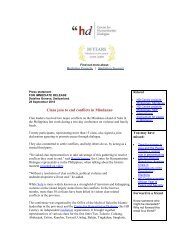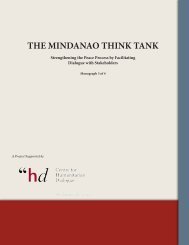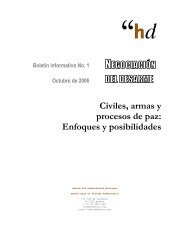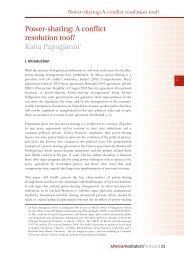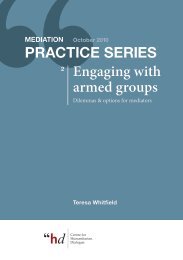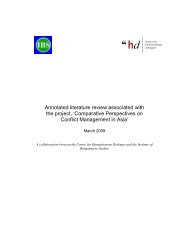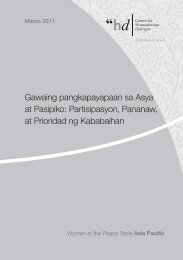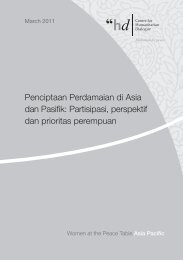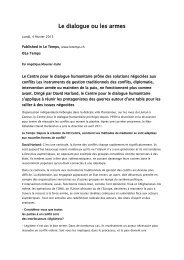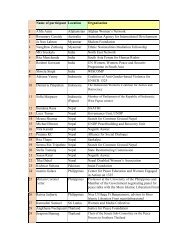Pagpati'ut - Centre for Humanitarian Dialogue
Pagpati'ut - Centre for Humanitarian Dialogue
Pagpati'ut - Centre for Humanitarian Dialogue
Create successful ePaper yourself
Turn your PDF publications into a flip-book with our unique Google optimized e-Paper software.
Mediating Violence In Sulu<br />
ownership<br />
control over parcels of land.<br />
Historical review: The antecedents. The regalian doctrine during the time<br />
of the Spaniards declares that all land within the jurisdiction of the colonial<br />
<br />
has been embedded in the post-colonial republic’s constitutions (1935,<br />
1973, and 1987), and hence, continues to this day. (Rodil 2003,149) 12<br />
Subsequently, the Torrens system under the American rule was instituted,<br />
requiring the “registration and titling of privately owned lands…Forest<br />
lands, bodies of water and so on which used to be sources of daily<br />
food and other needs <strong>for</strong> (sic) indigenous communities… have become<br />
state owned and could only be made use of with the consent of the<br />
government.” (Ibid 151)<br />
The colonial government, to further assert its authority over the territory<br />
and people, has passed discriminatory policies with regard to land, but<br />
<br />
(1) The Philippine Commission Act 718, passed on 4 April 1903, made void<br />
“land grants from Moro sultans or dattos of from chiefs of Non-Christian<br />
tribes when made without governmental authority or consent.” (Rodil<br />
2003, 152)<br />
(2) The Land Registration Act 496, passed on 6 November 1902, requires<br />
the registration of land, and the application <strong>for</strong> registration must be done<br />
“in writing, signed and sworn to by the applicant.” (Ibid 152) [Note that<br />
at the time that this Act was instituted, only very few are educated, nor<br />
<br />
(3) Public Land Act 926, passed on 7 October 1903, limits the land size<br />
that an individual can possess – a Christian can acquire 16 hectares<br />
each, while non-Christians cannot exceed ten hectares, with an additional<br />
condition <strong>for</strong> non-Christian owners to cultivate and improve the land within<br />
six months from the date that the land permit was granted. The permit<br />
<br />
The ten hectares allowed <strong>for</strong> non-Christians would eventually be reduced<br />
to four hectares under Commonwealth Act 41, as amended, passed on 7<br />
November 1936.<br />
26<br />
12 Rodil, Rudy. 2003. A Story of Mindanao and Sulu in Question and Answer. B.R.Rodil & Mincode



